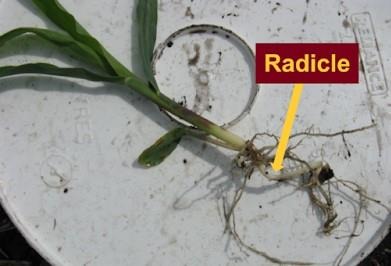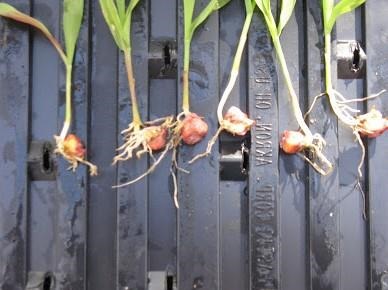By Dan Kaiser
Soils in most parts of Minnesota were dry this spring, which can cause issues when too high of a rate of starter fertilizer is applied for corn directly on the seed.
In-furrow, or pop-up, fertilizer application is a popular practice to help get the corn out of the ground more quickly. While there are benefits, there are also risks, such as reduced plant population if the rate of fertilizer is too high.
While there is not a truly safe rate you can apply directly on the seed, corn will tolerate some starter fertilizer. However, the rate of starter fertilizer that will be tolerated depends greatly on the soil type and moisture of the soil at planting. Dry soil conditions during early planting windows for corn present greater risks and fields should be scouted if you suspect seedling injury from starter fertilizer.
What should you look for?
Starter damage from in-furrow placement results in damage to the radicle, which is the first root that emerges from the seed as it develops. Damage to the radicle is usually easy to spot as it will be short and black or brown in color. If the radicle is damaged, the plant may still grow secondary roots but it will be set back in development and typically will be spindly in appearance. Once the radicle is damaged, there is no going back to fix the problem so you have to decide whether a replant is needed for the field. This decision will have to be made based on a case-by-case basis.

What causes starter fertilizer damage?
There is some debate as to what the main culprit is when it comes to seedling damage. All fertilizers are comprised of salts and the fertilizer salt index is typically used by those selling liquid fertilizer to promote safer options. While salts can be a problem, ammonia in the root zone can also be an issue. Ammonia can form when high rates of nitrogen (N) are applied in-furrow and especially when urea is present as a form of nitrogen in starter fertilizer. Typically, no more than 10 lbs of N + K2O should be applied directly on the corn seed for medium- to fine-textured soils when soil moisture conditions are optimal, and that rate drops to 4-5 lbs for sandy soils. In dry years, those numbers should be cut in half to reduce the risk of seedling damage as much as possible. Thiosulfate also can cause problems for germinating seed and should not be placed in-furrow if possible.
 |
| This photo shows reduced root growth and damage following a high rate of liquid starter fertilizer applied directly on the corn seed in a loamy sand. |
How much starter fertilizer should you apply?
Phosphorus (P) is the main nutrient responsible for boosting plant growth early in the growing season. However, if your soil tests are high in P or you are applying enough P fertilizer pre-plant, the growth boost with starter P fertilizer is largely cosmetic and will not result in greater yield. Starter fertilizer works best as a supplement to broadcast P fertilization in reduced tillage situations and in fields where it is difficult to build soil test levels. Our data clearly show that 10 lbs P2O5 is sufficient as a starter fertilizer to enhance early growth, providing similar yields to higher rates of starter P2O5 when used in conjunction with our suggested broadcast P fertilizer application rates.
Other considerations
This spring, there have been some instances of high rates of in-furrow starter fertilizer used in conjunction with fungicides applied in-furrow. If more than 5 gallons per acre of liquid fertilizer are needed, it is best to dilute the starter with water and apply no more than 5 gallons of fertilizer per acre. Dilution with water does not make a fertilizer used for in-furrow placement safer, but if you need volume, it is a better option than applying higher rates of starter fertilizer.
Remember, there is no truly safe rate of fertilizer than can be applied on the seed. Application of fertilizer in a band with at least 1 inch of soil between the band and the seed greatly reduces the risk of seedling damage. If dry weather conditions are present at planting, it is a better idea to reduce your starter rate to avoid damage.
Source : umn.edu